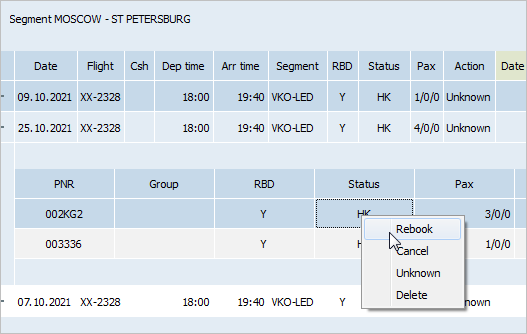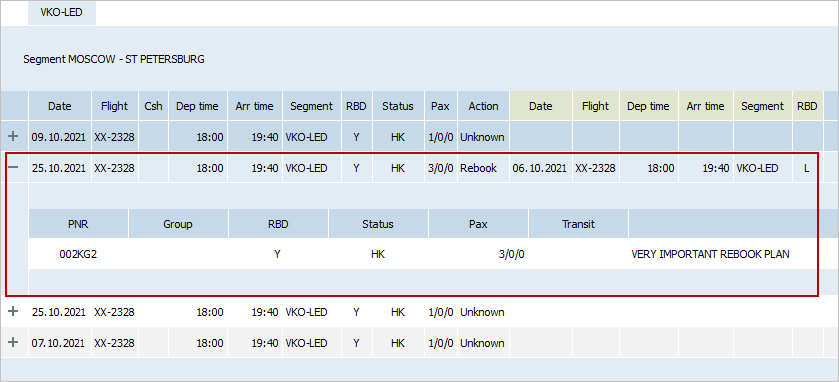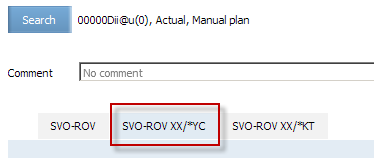Forming a Re-accommodation Solution
About Re-accomodation Solution
A solution for re-accommodation is a set of parameters of a suitable alternate flight for re-accommodation or cancellation of PNRs issued on a segment of a modified flight in the System.
It is possible to search a solution for re-accommodation in the automatic mode. The automatic search is carried out on the basis of specified conditions of business rules or in case of their absence on the basis of the general search algorithms.
It is possible to exclude possibility of assigning a modified flight as an alternate flight on the same departure date in the automatic formation of a solution for re-accommodation (see chapter Viewing Information about PNRs).
In addition, there is a possibility to form a solution for re-accommodation manually (see chapter Forming a Task on Re-accomodation in Manual Mode) by defining compliance of booking classes on alternate and modified flights for each PNR, a list of PNRs or all PNRs of a segment on a departure date of a modified flight.
If the alternate flight was not found during the automatic search, then the plan of reaccommodation is sent to the manual processing and the user is offered to define the alternate flight manually.
At the moment when the alternate flight is found for each PNR of the modified flight and it is defined what class of the alternate flight the passengers will be re-accommodated in, the plan of re-accommodation is considered to be formed.
Modes of Forming a Solution for Re-accommodation
One of the following actions may be a solution for re-accommodation:
In case if a task on re-accommodation is created by a user manually, it is possible to form a solution for re-accommodation manually or automatically.
When using the automatic mode of forming a solution for re-accommodation, searching an alternate flight is carried out according to conditions of business rules if they are assigned.
If no business rule is assigned, then searching an alternate flight is carried out within a search system range and a selection of a suitable alternate flight is carried out on the principle of saving a booking class that is, passengers of a modified flight are re-accommodated in booking classes with the same names on the alternate flight. Re-accommodation is carried out even if there are no free seats in the corresponding class of the alternate flight or this class is in the “Closed” status (LC) on conditions that cabin capacity is sufficient for this purpose.
If cabin capacity is not sufficient, then availability of the "Cap Oversell" business rule assigned for the alternate flight is checked in the System.
The flight is assigned as the alternate flight only in case if the condition of the business rule is fulfilled.
If a suitable alternate flight is not found, then it is required to find an alternate flight manually and form a solution for re-accommodation.
When using the manual mode of forming a solution for re-accommodation, conditions of the assigned business rules are not considered and it is suggested that a user should autonomously define suitable alternate flights on which passengers of PNRs on a segment will be re-accommodated as well as booking classes in which they will be re-accommodated.
| If you use Sale with Seat Selection, then use the "Seat Re-allocation" Business Rule to configure re-accommodation of passengers with booked seats. |
Levels of Forming Solution for Re-accommodation
It is possible to form a solution for re-accommodation manually on the following levels:
- a segment of a flight on a departure date
- passengers of a marketing carrier on a segment
- an individual PNR on a segment
- a list of PNRs.
To form a solution for re-accommodation for an individual PNR on a segment, carry out operations of forming solution for re-accommodation on the row containing the description of parameters of the corresponding PNR.
To form a solution for re-accommodation for a list of PNRs on a segment:
1. Select rows with the description of PNRs holding down Shift on the keyboard. The rows with the description of the PNRs will be marked with color.
2. Carry out operations of forming solution for re-accommodation on the selected rows.
If the formation of a solution for re-accommodation is carried out for a particular PNR, then information about each PNR is displayed on the screen of forming a plan of re-accommodation.
The information contains a PNR, parameters of passengers of the PNR and parameters of segments of the PNR:
To form a re-accommodation solution for passengers of the marketing carrier, execute operations on the corresponding tab.
Criteria of Forming a Solution for Re-accommodation in Automatic Mode
Rules of Forming a Solution for Re-accommodation
Re-accommodation is carried out by the following rules:
- Passengers of one PNR are re-accommodated on one flight.
- Passengers of the group booking who booked traffic in different PNRs are re-accommodated on one flight in the automatic mode. A user has an opportunity to organize re-accommodation at his or her discretion in the manual mode.
- Re-accommodation with rebooking over aircraft capacity is allowed only if the corresponding business rule is available.
- Possibility for an operating carrier to carry out re-accommodation of passengers of PNRs which are issued on a marketing carrier is defined by system settings.
- Re-accommodation is carried out for passengers of PNRs which have the “Confirmed booking”, “Waitlist” and “On request” statuses.
- Re-accommodation of passengers of PNRs which have the “Waitlist” status is easier and is carried out in one of the two modes (a mode selection is defined by system settings):
- “Cancellation of passengers from waitlist”: re-accommodation is not carried out, waitlist is cancelled.
- “Re-accommodation on waitlist”: re-accommodation is carried out with the same PNR status (the “Waitlist” status) on the first suitable alternate flight regardless of seat availability.
Defining Priority of PNRs Criteria
The following criteria affect definition of priority of a PNR for re-accommodation (in order of processing):
- Booking type (individual or group): individual bookings have priority over group bookings
- Service class: cabins with a higher service class have a priority over cabins with a lower service class
- TKT availability: PNR with TKT have priority over PNR without TKT
- PNR status:
- PNR with issued tickets
- Booked PNR
- PNR with the “Waitlist” status
- PNR route:
- PNRs on transit carry which contain segments of arrival and continuation of a route of the same carrier
- PNRs on transfer carry which contain segments of arrival and continuation of a route of another carrier
- Transit PNRs which contain a segment of continuation of a route of the same carrier
- PNRs on transfer carry which contain a segment of continuation of a route of another carrier
- PNRs on transit carry which contain a segment of arrival of the same carrier
- Transfer PNRs which contain a segment of arrival of another carrier
- Direct passengers of a specified flight for re-accommodation
- A number of passengers in a PNR: PNRs (with an individual booking) with a larger number of occupied seats have priority (“Infants without a seat” are not considered, passengers occupying more than one seat are considered)
- Passengers in a PNR: to define priority, the PNR weight parameter calculated depending on weight of a passenger category and a number of passengers of a certain category by formula is applied. (PNR weight = SUM (a number of passengers of i- category * weight of i- passenger category))
- By RBD: RBD having higher subclass have a priority (in accordance with RBD order of modifying flight)
- By PNR date creation: earlier date have priority.
It is possible to assign independently alternate flight for re-accommodating passengers of particular PNR during searching for re-accommodate solution in manual mode.
Information about passenger category weights is presented in Table:
| Passenger category | Passenger category weight |
|---|---|
| Frequent flying passengers | 7 |
| Patients requiring assistance | 6 |
| Infants (under 2 years) | 5 |
| Disability persons | 4 |
| Children (from 2 to 12 years) | 3 |
| Retirees | 2 |
| Other passengers | 1 |
Assignment of an Alternate Flight
Searching an Alternate Flight
The task of searching alternate flights is to define an alternate flight on which re-accommodation of passengers of a modified flight is possible.
The following modes of searching alternate flights are applied in the System:
- Manual searching alternate flights
- Automatic searching alternate flights.
Manual searching alternate flights is available only in the manual mode of forming a solution for re-accommodation and performs searching flights within a day (from 00:00 to 23:59) on a departure date of a segment of a modified flight with matching route points. It is possible to specify a free departure date, a segment and a flight number. While searching alternate flights in the manual mode, all conditions of business rules are ignored.
Automatic searching alternate flights is carried out in accordance with assigned business rules within the system search range. The system search range is assigned in the re-accomodation's general settings or by the "Search Flight range" business rule.
Creating a List of Suitable Alternate Flights
| Creating a list of suitable alternate flights is a system function. The list of alternate flights is available for viewing. |
The priority of alternate flights is defined by a smaller difference module between departure time of a modified flight and an alternate flight. If two flights are found, one of them is taking off earlier than the specified time of departure of the modified flight and the other one is taking off later with the same module difference, priority is given to the last flight.
If re-accommodation is carried out in the automatic mode, then after implementation of search flight process, checking compliance of alternate flights to the conditions of the "Manual control mode" business rule is carried out. If this checking is not successful, then the process of re-accommodation passes to the manual mode.
Selecting an Alternate Flight from the List
The system algorithm of selecting an alternate flight from the formed list is carried out by checking each flight from the list in order of their following on compliance to the certain conditions:
| Stage number | Condition formulation | Actions in case of fulfillment | Actions in case of nonfulfillment |
|---|---|---|---|
| 1 | Checking by principle of saving a booking class | Passengers are re-accommodated in booking classes with the same names on an alternate flight | Proceed to the next stage |
| 2 | Checking availability of the "Class matching" business rule | Proceed to the next stage | Checking the next flight on the list |
| 3 | Checking compliance to conditions of the "Class matching" business rule | Forming a solution for re-accommodation. A flight is assigned as an alternate one | Checking the next flight on the list |
If searching in the list produced no results, it is suggested that a user should manually define a cabin and a booking class of the alternate flight to which passengers will be re-accommodated.
Confirmation and Implementation of Re-accommodation Solution
After forming a solution for re-accommodation for each of PNRs on all segments of a modified flight, it is required to be confirmed.
To approve re-accommodation solution, press Apply on the re-accommodation plan screen. Re-accommodation plan will be applied, so PNR parameters will be changed.
In case of manual forming a task on re-accommodation as well as in cases when manual confirmation of a formed plan of re-accommodation is required, the plan is confirmed be a user. If a plan of re-accommodation was formed automatically and there are no reasons for manual confirmation, the plan is confirmed automatically.
After the plan is confirmed, its implementation begins. The status designating the current state of the implementation process is assigned to the plan of re-accommodation.
Statuses of implementation of a plan of re-accommodation are presented in Table.
| Status | Description |
|---|---|
| Actual | Plan of re-accommodation is being processed. A solution for re-accommodation is not confirmed |
| Completed | Solution for re-accommodation was confirmed and implemented |
If re-accommodation has not been completely performed, then a new re-accommodation task is formed with the same plan number and a following version number. This plan is to be proceeded manually.
If re-accommodation results in connection break between departure and arrival segments (e.g., departure on a segment comes before first segment arrival), then you may apply such plan manually even if connection break is restricted in Carrier Settings section.


